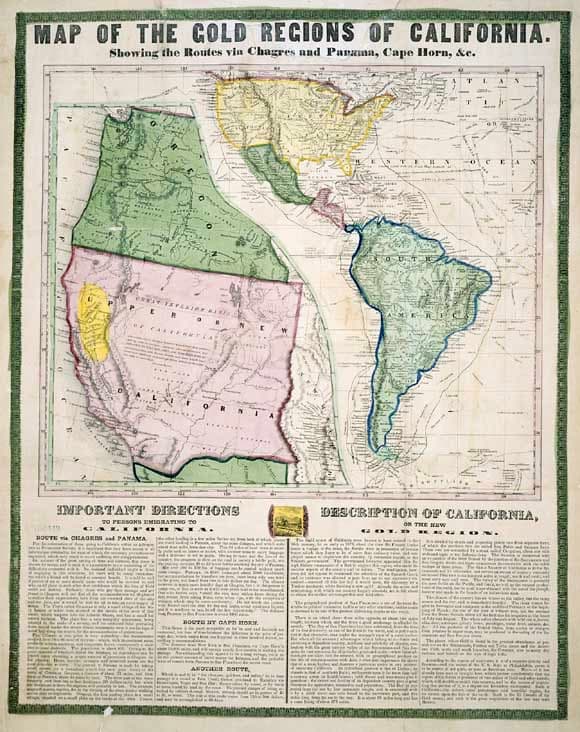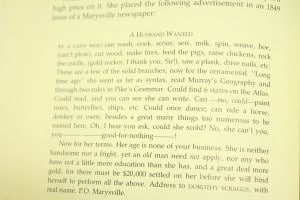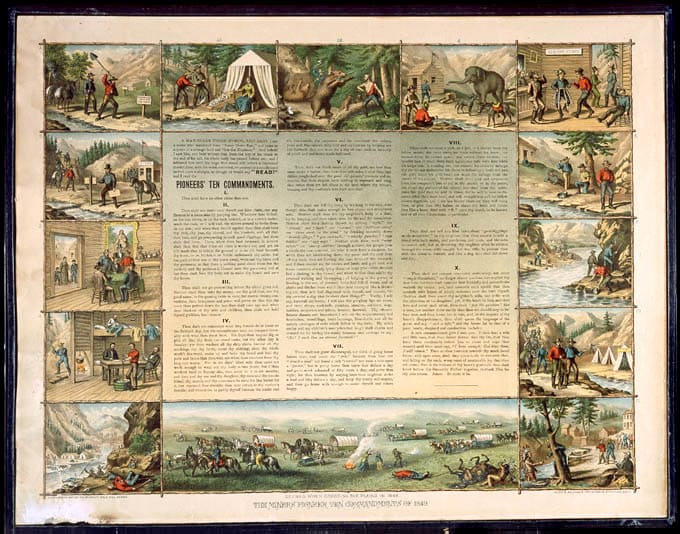“The Golden Girls”
Target: Middle/High School Social Studies
Skills: Sourcing, Contextualization, Corroboration
Topic: A Women’s History of The California Gold Rush
By: Monica Portugal
EQ: How were women treated in the California Gold Rush?
 Description: This lesson would best follow a lecture of the California Gold Rush in order to help students create a better connection to the following documents. The purpose of this lesson is to provide a women’s history of this commonly viewed, male centered adventure.
Description: This lesson would best follow a lecture of the California Gold Rush in order to help students create a better connection to the following documents. The purpose of this lesson is to provide a women’s history of this commonly viewed, male centered adventure.
Directions: Students will first write a half page reflection as to what they thought women in the Gold Rush looked like, acted, or did. Students will then read each document in groups of 2-4, and answer the accompanying questions that go with it. As a class we will then share our answers and have an open discussion on the documents we just read.
At the end of this lesson, students will individually reflect on their answers, write a summary about the lesson, and answer the EQ. Students will then compare and contrast the reflection they wrote before the lesson, and the reflection they written after.
Source #1: Newspaper Article
- Using prior knowledge about the California Gold Rush, what surprises you in source 1, and how has it changed your image of the Gold Rush?
- What does this document tell us about the women who ventured to California during the rush? (Occupation, income, attitudes)
Mrs. Farnham In California (February 27, 1850) “Women are more in requisition than gold, or anything else Those who came out with me had immediately offers of employment at $75 and $100 per month. If there had been five hundred instead of five, they could all have engaged immediately on similar terms. They must be got here in considerable numbers before society can take any shape or assume any character. I hope that while our good brethren at home are bestirring themselves kindly lo send out clergymen, they will not forget that the best of all missionaries to such a population are resolute, virtuous, intelligent women. One of the chief difficulties that were felt by the women who consulted me, was the fear that they should not be protected against rudeness, or perhaps something worse. I reasoned with them that it would not be so, but it was difficult to convince by argument . Therefore let the fact be known to all who care to know it, that the utmost possible deference and care are shown to females; and that any woman, to experience rudeness or insult here, must expose herself much more imprudently than she would to incur the same risk in your cities. No woman need fear to come here who has the sense and energy to take care of herself elsewhere; and she will have, in her capacity for any occupation suited to her sex. a better capital than the gold mines. If there had 1,000 females sailed last May, they would, all who chose to, be profitable employed this day . Everything is scarcer here than gold.” -Eliza Farnham
Source #2: Advertisement
- After reading this document, who do you think the audience is, and what do you think was the purpose of this document?
A Husband Wanted
“By a lady who can wash, cook, scour, sew, milk, spin, weave, hoe (can’t plow), cut wood, make fires, feed the pigs, raise chickens, rock the cradle, (gold-rocker, I thank you, Sir!), saw a plank, drive nails, etc. There are a few of the solid branches; now for the ornamental. “Long time ago” she went as far as syntax, reap Murray’s Geography and through two rules in Pike’s Grammar. Could find 6 states on the Atlas. Could read, and you can see she can write. Can - no, could - paint roses, butterflies, ships, etc. Could once dance; can ride a horse, donkey or oxen, beside a great many things too numerous to be named here. Oh I hear you ask, could she scold? No, she cant you --- you---- good-for-nothing----! Now for her terms. Her age is none of your business. She is neither handsome nor a fright, yet an old man need not apply, nor any who not a little more education then she has, and great deal more gold, for there must be $20,000 settled on her before she will bind herself all the above. Address to Dorothy Scraggs, with real name. P.O Marysville.”
- After reading the given documents, what do these sources tell us about women in the Gold Rush?
- Do you think these sources agree with another, or disagree?
- What inferences can we make about women who were present in the California during the Gold Rush?
Brief Summary/Reflection:
The combination of these documents and the scaffolding questions that accompany them, are intended for students to reflect on this history, and look at these primary sources in a new light in the context of its history. Students will be required to consider the purpose of these documents, and why the authors would have written them. Students will also be forced to consider how these documents are in dialogue with another, and determine whether these sources provide the evidence needed to support their final claims.
For this mini lesson I wanted to provide primary sources that were fun and interesting to read, while at the same time provide a different perspective on the history of the Gold Rush. I stumbled upon these documents while working on a research paper and loved how it showed a completely different image of the 19th century women. I am currently conducting my student teaching at a high school, and have shared some of the documents I am using for my senior thesis with my students. As I was telling them the story of some of my sources, I was pleased to see their interest light up, and their curiosity begin to creep in. It is because of reactions such as those that I hope to provide my students with sources that make them question the context of it, and discover a new story to be told.
Image Sources:
http://Photo From: California State Library: https://www.library.ca.gov/goldrush/images/goldrush_pic/II_img1.jpg
https://www.library.ca.gov/goldrush/images/goldrush_pic/VII-2_img2.jpghttp://www.sierracollege.edu/ejournals/jsnhb/v4n2/farnham.html
Source #1:
Ilinois Digital Newspaper Collection: http://idnc.library.illinois.edu/cgi-bin/illinois?a=d&d=SJO18500227.2.146
Source #2:
JoAnn Levy, They The Elephant. (University of Oklahoma Press, 2014), 176.



